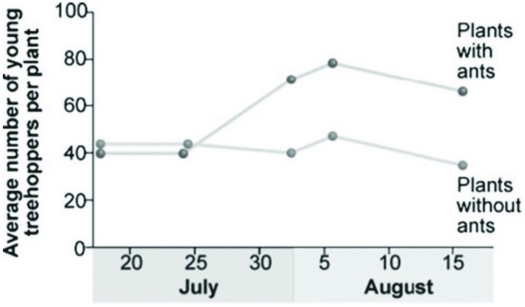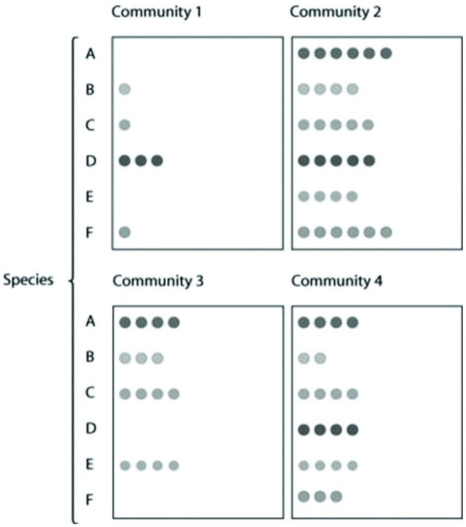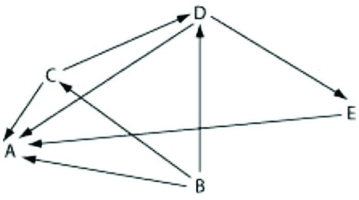A) +/0 will always remain such.
B) A +/− interaction could shift to +/0 or +/+ over time, depending on other factors such as competition, population density, or environmental changes.
C) Species interactions occur in isolation and cannot affect the structure of ecological communities.
D) A −/− interaction benefits both of the species in the relationship.
Correct Answer

verified
Correct Answer
verified
Multiple Choice
Which of the following is a correct statement about MacArthur and Wilson's island equilibrium model?
A) As the number of species on an island increases, the emigration rate decreases.
B) Competitive exclusion is less likely on an island that has large numbers of species.
C) Small islands receive few new immigrant species.
D) Islands closer to the mainland have higher extinction rates.
Correct Answer

verified
Correct Answer
verified
Multiple Choice
Which of the following best describes the consequences of white-band disease in Caribbean coral reefs?
A) Staghorn coral is decimated by the pathogen, and Elkhorn coral takes its place.
B) Key habitat for lobsters, snappers, and other reef fishes improves.
C) Algal species take the place of the dead coral, and the fish community is dominated by herbivores.
D) Algal species take over and the overall reef diversity increases due to increases in primary productivity.
Correct Answer

verified
Correct Answer
verified
Multiple Choice
Use the figure to answer the following question.  Treehoppers (a type of insect) produce honeydew, which ants use for food. Treehoppers have a major predator, the jumping spider. Researchers hypothesized that the ants would protect the treehoppers from the spiders. In an experiment, researchers followed study plots with ants removed from the system and compared them to a control plot. Which of the following conclusions is best supported by the data provided in the figure?
Treehoppers (a type of insect) produce honeydew, which ants use for food. Treehoppers have a major predator, the jumping spider. Researchers hypothesized that the ants would protect the treehoppers from the spiders. In an experiment, researchers followed study plots with ants removed from the system and compared them to a control plot. Which of the following conclusions is best supported by the data provided in the figure?
A) Ants do somehow protect the treehoppers from spiders.
B) Ants eat the honeydew produced by treehoppers.
C) Ants reduce the numbers of treehoppers.
D) No specific conclusions can be drawn from this figure.
Correct Answer

verified
Correct Answer
verified
Multiple Choice
Which claim best explains the observation that species richness is higher in tropical regions than in temperate regions?
A) tropical communities are younger
B) tropical regions generally have more available water and higher levels of solar radiation
C) higher temperatures cause more rapid speciation
D) tropical regions have very high rates of immigration and very low rates of extinction
Correct Answer

verified
Correct Answer
verified
Multiple Choice
Which of the following best explains why moderate levels of disturbance result in an increase in community diversity?
A) Habitat is opened up for less competitive species.
B) Competitively dominant species infrequently exclude less competitive species after a moderate disturbance.
C) The resulting uniform habitat supports stability, which in turn supports diversity.
D) Less-competitive species evolve strategies to compete with dominant species.
Correct Answer

verified
Correct Answer
verified
Multiple Choice
Use the figure to answer the following question.  In the figure, species A through F are found among four communities, with the number of circles representing their abundance. Which community has the highest diversity?
In the figure, species A through F are found among four communities, with the number of circles representing their abundance. Which community has the highest diversity?
A) an invasive species
B) a keystone species
C) a primary producer
D) a secondary consumer
Correct Answer

verified
Correct Answer
verified
Multiple Choice
In a particular case of secondary succession, three species of wild grass all invaded a field. By the second season, a single species dominated the field and the other two species had a lower relative abundance. A possible factor contributing to the abundances of these species in this example of secondary succession is ________.
A) equilibrium
B) immigration
C) inhibition
D) parasitism
Correct Answer

verified
Correct Answer
verified
Multiple Choice
Which of the following is a widely supported explanation for the tendency of tropical communities to have greater species diversity than temperate or polar communities?
A) There are fewer parasites to negatively affect the health of tropical communities.
B) Tropical communities are low in altitude, whereas temperate and polar communities are high in altitude.
C) Tropical communities have higher sunlight and precipitation, and are generally older than temperate or polar communities.
D) More competitive dominant species have evolved in temperate and polar communities.
Correct Answer

verified
Correct Answer
verified
Multiple Choice
Approximately how much total biomass of plant material would hypothetically be necessary to support six carnivorous lions (whose diet consists only of herbivorous prey) , each weighing 50 kg, living in a given area along with their prey, on an ongoing basis? (Assume a 10% efficiency in energy transfer.)
A) 130,000 kg
B) 30,000 kg
C) 3,000 kg
D) 1,500 kg
Correct Answer

verified
Correct Answer
verified
Multiple Choice
Use the following diagram of a hypothetical food web to answer the question. In this particular scenario, the arrows represent the transfer of energy between the various organisms and decomposers are included in the diagram.  Which letter best represents a primary consumer in the community?
Which letter best represents a primary consumer in the community?
A) A
B) B
C) C & D
D) D only
Correct Answer

verified
Correct Answer
verified
Multiple Choice
Which of the following best explains why a pathogen is generally more virulent in a new habitat?
A) Intermediate host species are more motile and transport pathogens to new areas.
B) Pathogens evolve more efficient forms of reproduction in new environments.
C) Hosts in new environments have not had a chance to become resistant to the pathogen through natural selection.
D) New environments are almost always smaller in area so that transmission of pathogens is easily accomplished between hosts.
Correct Answer

verified
Correct Answer
verified
Multiple Choice
As you study two closely related predatory insect species, the two-spot and the three-spot avenger beetles, you notice that each species seeks prey at night when present in an area where the other beetle species is absent. However, where their ranges overlap, the two-spot avenger beetle hunts at night and the three-spot hunts in the morning. When you bring them into the laboratory and isolate the two different species, you discover that the offspring of both species are nocturnal. The observations above indicate that the two species most likely demonstrate which of following ecological processes? You have discovered an example of ________.
A) mutualism
B) character displacement
C) Batesian mimicry
D) resource partitioning
Correct Answer

verified
Correct Answer
verified
Multiple Choice
Use the figures to answer the following question.  The different shaded squares in the figure, from white to darker gray, represent different species, and more squares of a shade correspond to a higher abundance. According to the Shannon Diversity Index, which of the five blocks above, with each containing 36 squares, represents the greatest diversity?
The different shaded squares in the figure, from white to darker gray, represent different species, and more squares of a shade correspond to a higher abundance. According to the Shannon Diversity Index, which of the five blocks above, with each containing 36 squares, represents the greatest diversity?
A) 1
B) 2
C) 4
D) 5
Correct Answer

verified
Correct Answer
verified
Multiple Choice
Five hypothetical forest communities, each have one hundred individuals distributed among four different tree species (W, X, Y, and Z) . Which of the following combinations of species in a forest community would make it the most diverse?
A) 25W, 25X, 25Y, 25Z
B) 40W, 30X, 20Y, 10Z
C) 50W, 25X, 15Y, 10Z
D) 70W, 10X, 10Y, 10Z
Correct Answer

verified
Correct Answer
verified
Multiple Choice
The principle of competitive exclusion states that ________.
A) two species cannot coexist in the same habitat
B) competition between two species always causes extinction or emigration of one species
C) two species that have exactly the same niche cannot coexist in a community
D) two species will stop reproducing until one species leaves the habitat
Correct Answer

verified
Correct Answer
verified
Multiple Choice
The oak tree pathogen that causes sudden oak death, Phytophthora ramorum, has dispersed 800 kilometers in 15 years. West Nile virus spread from New York State to 46 other states in 5 years. Which of the following best explains the difference in the rate of spread of these two pathogens?
A) the lethality of each pathogen
B) the mobility of their hosts
C) the fact that viruses are very small
D) innate resistance
Correct Answer

verified
Correct Answer
verified
Multiple Choice
Food chains are sometimes short because ________.
A) only a single species of herbivore feeds on each plant species
B) local extinction of a species causes extinction of the other species in its food chain
C) the transfer of energy from one trophic level to the next higher level is inefficient
D) most producers are inedible
Correct Answer

verified
Correct Answer
verified
Multiple Choice
In terms of community ecology, which of the following best explains why pathogens are often more virulent now than in the past?
A) More new pathogens have recently evolved.
B) Host organisms have become more susceptible because of weakened immune systems.
C) Human activities are transporting pathogens into new habitats (or communities) at an unprecedented rate.
D) Medicines for treating pathogenic disease are in short supply.
Correct Answer

verified
Correct Answer
verified
Multiple Choice
Use the following diagram of five islands formed at around the same time near a particular mainland, as well as the principles of MacArthur and Wilson's island equilibrium model, to answer the question.  Which region would likely have the greatest species diversity?
Which region would likely have the greatest species diversity?
A) island 1
B) island 3
C) island 4
D) the mainland
Correct Answer

verified
Correct Answer
verified
Showing 21 - 40 of 71
Related Exams